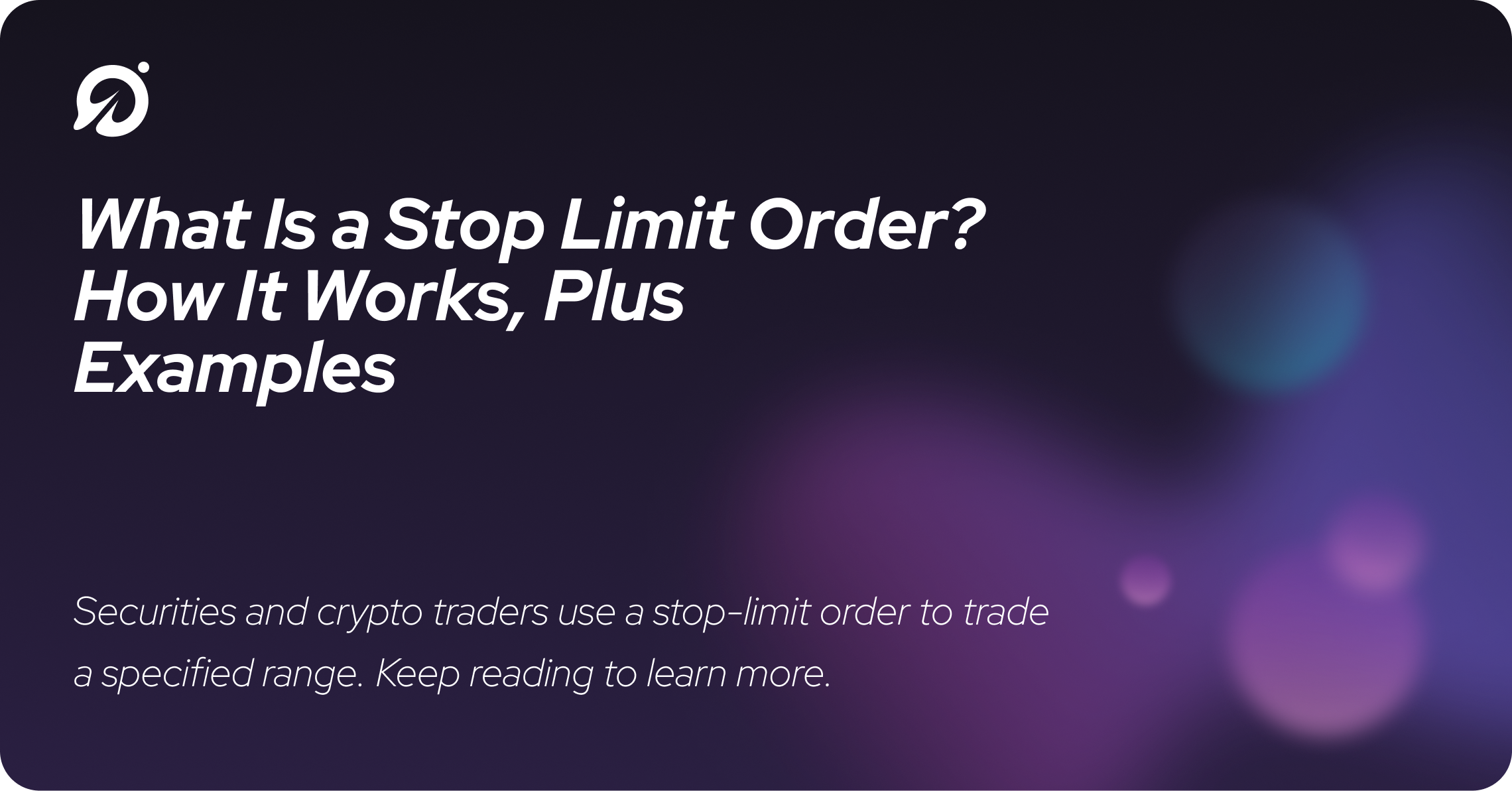What Is a Stop Limit Order? How It Works, Plus Examples
A stop limit order is an advanced type of order used by stock and cryptocurrency traders. It combines the characteristics of a stop order and a limit order.

Disclaimer: This is for informational purposes and is not meant to serve as financial or investing advice.
What Is a Stop Limit Order?
In a stop limit order, a stop price gets set. Once that price is triggered, the order converts to a limit order. The limit price may be the same or greater than the stop price.
How Are Stop Limit Orders Used?
The point of a stop limit order is to use the best of both trade types to give the trader fine-tuned control over their execution prices.
You must set two price points: the stop price and the limit price. The stop price or trigger price is when the order becomes a limit order.
Once the trigger price is reached, the trade will only execute if the limit order is reached too.
In the case of a buy-stop-limit order, the trader sets a market price above which the order becomes a limit order. The limit price is the highest price they are willing to pay for the order.
For example, if you set a stop price of $40 and a limit of $45, you are willing to pay $45 after the price reaches $40 but not above $45. The order will not fill if the market price goes above $45.
A sell-stop limit order gets placed below market price. If you set a stop price of $15 with a limit price of $10, you are willing to sell for more than $10 after the price reaches $15.
The trade will not fill if the current market price falls below $10.
How Are Stop Limits Different in Crypto vs. Stocks?
Stop most stock brokerages, and some crypto exchanges offer limit orders. These orders are more likely to be provided on markets with greater liquidity, like Bitcoin and Ethereum, than altcoins.
Stock traders use stop limit orders to enter trades when a specific price is hit but up to a specific price. Stop-limit orders can be day orders or good-til-canceled (GTC). Day orders expire after the trading day ends and the market closes.
Crypto markets, of course, don’t have daily sessions. The market’s trading hours are 24/7. Some day traders move from stocks to crypto during after-hours trading.
GTC orders stay on the book indefinitely until canceled, although most brokerages have a limit of anywhere from 30-60 days that you can keep them.
With certain brokerages and crypto exchanges, you select time frames for your orders to remain open through. On decentralized exchanges, you may have to pay fees to keep unfilled orders on the book.
What Are Some Trading Strategies for Stop Limit Orders?
Reducing Losses
Unlike regular sell limit orders, which fill at a given price or lower, a stop limit order only fills at that price if the stop price is reached first. This can help traders limit losses while also locking in the upside.
The sell limit price is the minimum price your trade can be executed at.
Let’s give an example. Say Stock A is trading at $110, and you want to protect your downside. You want to sell if it goes below $100, but you don't want to get a worse price than $95. So what do you do?
Set a sell-stop limit order with the stop at $100 and the limit at $95. You won't sell your shares if the price dips below $95. Your trade can only be executed above $95 after the price has crossed under $100.
Because the stop limit order works like an if-then statement, it is called a conditional order.
What Are the Advantages of Stop Limit Orders?
Stop limit orders allow traders to lock in profits like limit orders and limit downside like stop loss orders without filling trades at unpredictable market prices.
Like trailing stop orders, stop limit orders allow trader to automate their trading. This takes the human emotion out of trades and makes you less likely to make a mistake.
But because stop limit orders only fill in a specific price range, traders can make the mistake of making their limit range too narrow and not having their orders filled.
Stop-limit orders aren’t always used to try to buy or sell at a specified price range. You may set a long-term trade window using stop-limit orders.
A trader uses technical analysis to determine that a stock has a crucial resistance at $100 while the stock only trades for $75. They might set a stop at $100 and a limit at $120, just in case.
The trader’s thesis is that the stock will only break past $100 if it has lots of momentum but that any price the stock reaches above $120 is overpaying for the stock.
Stop-limit orders can help limit high fills on trades with fast price moves.
What Are the Disadvantages of Stop Limit Orders?
There is no guarantee that your stop limit order will get filled. So you may miss out on profits or incur unrealized losses.
If your stop and limit prices are too close, the market price might rip past them without filling, and your trade won’t execute. This is common in cryptocurrency trading, where volatility is high.
Experienced traders use multiple orders on one trade to ensure they get a fill or at least a partial fill.
The other disadvantage of stop-limit orders is that you can’t always set and forget them. Sometimes the stock price increases sharply and crosses your stop price.
You may evaluate the trade price and think the stock shows momentum, most often analyzing the price of the stock against its past performance. If you were just trading spot, you wouldn’t have to do anything, but in this case, you would have to cancel your limit order manually.
What Are Some Examples of Stop Limit Orders?
Scenario A - Buy Order Filled.
The trader sets a stop limit order with the stop at $18 and limit at $25. The market price increases to $19; the order is converted to a limit order and filled at $19.50.
If the price had crossed $19 and quickly “gapped up” to $26, the order would not have been filled. Market gaps occur in high-volatility markets.
Scenario B - Sell Order Filled.
The trader sets a stop limit order with the stop price at $20 and the limit price at $13. The market price decreases from $21 to $15, and the order gets filled at $15.
Scenario C - Sell Order Unfilled.
The trader wants to set a tight stop limit order, so they get the best price possible when selling. So they set a stop price of $50 and a limit price of $48. That way, their order price can only vary by 4% maximum.
Unfortunately for the trader, the market moves sharply from $55 to $45, and his order is unfilled. Better luck next time.
The Bottom Line
A stop limit order is a type of order used by stock and crypto traders to combine the useful properties of stop orders and limit orders.
When the specified stop price is reached, it’s converted to a limit order. The limit order is the maximum price the trader will pay in a buy order and the minimum price a trader will pay in a sell order.
Many use stop-limit orders to manage risk and finely control their profit-taking levels. Stop-limit orders are also beneficial for avoiding market price gaps.
Because the stock market has trading sessions each day, a stock price can open at a much higher or lower price. Stop-limit orders help traders avoid getting bad fills due to after-hours price fluctuations.
Stop limit orders are another tool in an intelligent trader’s toolbelt. Check out the rest of our blog and our Youtube channel to learn more about other stock and crypto trading strategies.
Sources:
Stop-Limit Order: What It Is and Why Investors Use It | Investopedia
